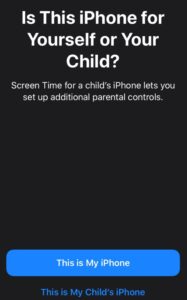


This article was originally published on September 8.How to choose the best ad blocker for iOSĪpple products come with settings designed to protect your privacy, but they fall short when it comes to blocking ads and trackers.
#Add blocker for iphone how to
Go to your iPhone Settings > General > Software Update and download and install iOS 16.6.1 as soon as possible.Ġ9/09 updated to include information about Apple’s Rapid Security Response updates and how to detect spyware.
#Add blocker for iphone upgrade
If you want to stay secure, you’ll need to upgrade to iOS 16.6.1 manually-even if you have enabled automatic Apple updates, they roll out to iPhones in a gradual process. The iOS 16.6.1 upgrade is available for the iPhone 8 and later, iPad Pro, iPad Air 3rd generation and later, iPad 5th generation and later, and iPad mini 5th generation and later.
#Add blocker for iphone mac
Wright also warns that the Wallet vulnerability fixed in iOS 16.6.1 is present in Apple Watch-and the ImageIO issue is fixed in a new Mac update, so check and upgrade all your Apple devices. While he concedes that attacks using these vulnerabilities are targeted, “it’s still important to update with a sense of urgency.” It’s important to update to iOS 16.6.1 as soon as you can, says independent security researcher Sean Wright. Whether you are a target or not, the more information available about the flaws, the more attackers can use them to target iPhone users. Given the seriousness of the flaws, it goes without saying that you should update to iOS 16.6.1 now. It’s therefore only worth using if you think you’d be a target. To prevent spyware from reaching you in the first place, Apple’s Lockdown Mode is also a good idea if your iPhone is at greater risk of attack-but be warned, it does make your device almost unusable. People hardly ever do this, so why not try it now (once you have updated)-turn off your iPhone, turn it back on, simple. It’s tough to get rid of spyware, but some suggest restarting your iPhone can disrupt it. In addition, tools such as iVerify can help to detect whether the malware is on your device. Spyware is extremely stealthy and people usually have no idea it’s on their phone, but it might be slightly slower than usual. Spyware can reach the device without the user even having to click-hence the term “zero-click” attack. Nation-state attackers usually use it on high-profile targets.Īttacks can reach iPhones via a message containing an image sent on iMessage in the case of the iOS 16.6.1 flaw. The Pegasus spyware is already famous because it has been used multiple different times. Spyware is a nasty attack method because it allows the adversary to see pretty much everything you do on your iPhone. What Is A Spyware Attack And How Can I Tell If I am Affected? This is even more true when the details are out there because it opens the door for more adversaries to try and take control of people’s iPhones. In security, the time between exploited attacks and fixes-as well as people applying those patches, is key. Citizen Lab timed the iOS 16.6.1 fix with a blog detailing what had happened and how the attack exploiting the vulnerabilities was performed. What if it went wrong again? Not only would Apple look bad, but the attack was already out there. Of course, Apple itself tends to stay quiet about the ifs and whys, but my guess is that the fix in iOS 16.6.1 was far too important to risk. It was a high-profile error, which led to the iPhone maker being red-faced-but my understanding is that Apple never wanted that sort of bad optics to happen again. That’s in theory, anyway.Ī couple of months ago, Apple issued a Rapid Security Response update that had to be retracted because the fix broke something else. This new feature in iOS 16 sees Apple push security-only upgrades to your phone in an easy-to-download and install size to ensure you are always protected. Some of you might wonder why iOS 16.6.1 wasn’t released as a Rapid Security Response Update. “The exploit can be used by an attacker w/out the victim taking an action,” she added.“Here, the attacker can send the attack via iMessage & compromise device to spy/harm.” Why Wasn’t iOS 16.6.1 Released As A Rapid Security Response? “These exploits are usually used against folks with high threat models-people in the public eye, folks working in government, individuals being targeted or harassed by nation state actors, journalists,” security expert Rachel Tobac wrote in a tweet.


 0 kommentar(er)
0 kommentar(er)
